Rapid Identification of 3,6′-Disinapoyl Sucrose Metabolites in Alzheimer’s Disease Model Mice Using UHPLC–Orbitrap Mass Spectrometry
Abstract
:1. Introduction
2. Materials and Methods
2.1. Chemicals and Reagents
2.2. Animals
2.3. Microinjection and Surgery
2.4. Novel Object Recognition Test (NORT)
2.5. Morris Water Maze (MWM) Test
2.6. Sample Collection and Preparation
2.6.1. Plasma Sample Collection
2.6.2. Urine Sample Collection
2.6.3. Feces Sample Collection
2.6.4. Plasma, Urine, and Feces Samples Preparation
2.6.5. Tissue Sample Collection and Preparation
2.7. Nissl Staining
2.8. Instruments and Analytical Conditions
2.9. Data Processing and Statistical Analyses
3. Results
3.1. Novel Object Recognition Test (NORT)
3.2. Morris Water Maze Test
3.3. Neuronal Pathology in the Hippocampal Region
3.4. Analysis of Mass Fragmentation Behavior of DISS
3.5. Identification of DISS Metabolites
4. Discussion
5. Conclusions
Author Contributions
Funding
Institutional Review Board Statement
Data Availability Statement
Conflicts of Interest
Sample Availability
References
- Joe, E.; Ringman, J.M. Cognitive symptoms of Alzheimer’s disease: Clinical management and prevention. BMJ 2019, 367, 16217–16230. [Google Scholar] [CrossRef] [Green Version]
- Liang, S.; Wang, Z.; Yuan, J.; Zhang, J.; Dai, X.; Qin, F.; Zhang, J.; Sun, Y. Rapid identification of tanshinone IIA metabolites in an Amyloid-β1–42 induced Alzheimer’s disease rat model using UHPLC–Q–Exactive Qrbitrap mass spectrometry. Molecules 2019, 24, 2584. [Google Scholar] [CrossRef] [Green Version]
- Takahashi, R.H.; Nagao, T.; Gouras, G.K. Plaque formation and the intraneuronal accumulation of β-amyloid in Alzheimer’s disease. Pathol. Int. 2017, 67, 185–193. [Google Scholar] [CrossRef]
- Tan, J.Z.A.; Gleeson, P.A. The role of membrane trafficking in the processing of amyloid precursor protein and production of amyloid peptides in Alzheimer’s disease. BBA-Biomembranes 2019, 1861, 697–712. [Google Scholar] [CrossRef]
- Xin, W.; Xuan, Z.; Gongying, L.; Yun, Z.; Yili, W.; Weihong, S. Modifications and trafficking of APP in the pathogenesis of Alzheimer’s disease. Front. Mol. Neurosci. 2017, 10, 20–32. [Google Scholar]
- Shutaro, K.; Hiroyuki, K.; Miyuki, I.; Sachiko, N.; Chihiro, T.; Kaori, K.; Kotaro, T.; Kenichi, M.; Michihiro, F.; Katsunori, I. Overexpression of Swedish mutant app in aged astrocytes attenuates excitatory synaptic transmission. Physiol. Rep. 2016, 4, e12665. [Google Scholar]
- Reddy, P.H.; Yin, X.; Manczak, M.; Kumar, S.; Pradeepkiran, J.A.; Vijayan, M.; Reddy, A.P. Mutant APP and Amyloid beta-induced defective autophagy, mitophagy, mitochondrial structural and functional changes and synaptic damage in hippocampal neurons from Alzheimer’s disease. Hum. Mol. Genet. 2018, 14, 2502–2516. [Google Scholar] [CrossRef]
- Tcw, J.; Goate, A.M. Genetics of β-amyloid precursor protein in Alzheimer’s disease. Cold Spring Harb. Perspect. Med. 2017, 7, a024539. [Google Scholar] [CrossRef]
- Cao, G.; Su, P.; Zhang, S.; Guo, L.; Zhang, H.; Liang, Y.; Qin, C.; Zhang, W. Ginsenoside Re reduces Aβ production by activating PPARγ to inhibit BACE1 in N2a/APP695 cells. Eur. J. Pharmacol. 2016, 793, 101–108. [Google Scholar] [CrossRef] [PubMed]
- Zhang, Z.X.; Li, Y.B.; Zhao, R.P. Epigallocatechin gallate attenuates β-amyloid generation and oxidative stress involvement of PPARγ in N2a/APP695 cells. Neurochem. Res. 2017, 42, 468–480. [Google Scholar] [CrossRef] [PubMed]
- Rhian, S.T.; Mouhamed, A.; Justin, S.B.; Martha, H.E.; Mark, A.G.; Emma, J.K. Alterations in endocytic protein expression with increasing age in the transgenic APP695 V717I London mouse model of amyloid pathology: Implications for Alzheimer’s disease. Neuroreport 2017, 28, 963–968. [Google Scholar]
- Ştefănescu, R.; Stanciu, G.D.; Luca, A.; Caba, I.C.; Tamba, B.I.; Mihai, C.T. Contributions of mass spectrometry to the identification of low molecular weight molecules able to reduce the toxicity of Amyloid-β peptide to cell cultures and transgenic mouse models of Alzheimer’s disease. Molecules 2019, 24, 1167. [Google Scholar] [CrossRef] [Green Version]
- Zhu, Y.; Duan, X.; Cheng, X.; Cheng, X.; Li, X.; Zhang, L.; Liu, P.; Su, S.; Duan, J.; Dong, T.T.X.; et al. Kai-xin-san, a standardized traditional chinese medicine formula, up-regulates the expressions of synaptic proteins on hippocampus of chronic mild stress induced depressive rats and primary cultured rat hippocampal neuron. J. Ethnopharmacol. 2016, 423–432. [Google Scholar] [CrossRef]
- Fu, H.; Xu, Z.; Zhang, X.L.; Zheng, G.Q. Kaixinsan, a well-known chinese herbal prescription, for Alzheimer’s disease and depression: A preclinical systematic review. Front. Neurosci. 2020, 13, 1421–1440. [Google Scholar] [CrossRef] [PubMed] [Green Version]
- Zhu, Y.; Duan, X.; Huang, F.; Cheng, X.; Zhang, L.; Liu, P.; Su, S.; Duan, J.A.; Dong, T.T.X.; Tsim, K.W.K. Kai-xin-san, a traditional chinese medicine formula, induces neuronal differentiation of cultured PC12 cells: Modulating neurotransmitter regulation enzymes and potentiating NGF inducing neurite outgrowth. J. Ethnopharmacol. 2016, 193, 272–282. [Google Scholar] [CrossRef] [PubMed]
- Wang, N.; Jia, Y.; Zhang, B.; Li, Y.; Murtaza, G.; Huang, S.; Liu, X. Kai-xin-san, a chinese herbal decoction, accelerates the degradation of β-amyloid by enhancing the expression of neprilysin in rats. Evid. Based Complement. Alternat. Med. 2020, 2020, 3862342. [Google Scholar] [CrossRef] [PubMed] [Green Version]
- Shi, Q.; Geng, S.; Chen, J.; Zhou, Q.; Jin, Y.; Lei, H.; Luan, L.; Liu, X.; Wu, Y. An efficient procedure for preparing main acylated pentasaccharides from polygalae radix using integrated extraction-adsorption method followed by semi-preparative high performance liquid chromatography. Sep. Purif. Technol. 2015, 153, 84–90. [Google Scholar]
- Liu, P.; Hu, Y.; Guo, D.H.; Wang, D.X.; Tu, H.H.; Ma, L.; Xie, T.T.; Kong, L.Y. Potential antidepressant properties of radix polygalae (Yuan Zhi). Phytomedicine 2010, 17, 794–799. [Google Scholar] [CrossRef] [PubMed]
- Hu, Y.; Liao, H.B.; Guo, D.H.; Liu, P.; Wang, Y.Y.; Rahman, K. Antidepressant-like effects of 3,6′-disinapoyl sucrose on hippocampal neuronal plasticity and neurotrophic signal pathway in chronically mild stressed rats. Neurochem. Int. 2010, 56, 461–465. [Google Scholar] [CrossRef]
- Hu, Y.; Liu, M.Y.; Liu, P.; Dong, X.Z.; Boran, A.D.W. Neuroprotective effects of 3, 6′-disinapoyl sucrose through increased BDNF levels and CREB phosphorylation via the CAMKII and ERK1/2 pathway. J. Mol. Neurosci. 2014, 53, 600–607. [Google Scholar] [CrossRef]
- Liu, X.; Wang, D.; Zhao, R.; Dong, X.; Hu, Y.; Liu, P. Synergistic neuroprotective effects of two herbal ingredients via CREB-dependent pathway. Front. Pharmacol. 2016, 7, 337–344. [Google Scholar] [CrossRef] [PubMed] [Green Version]
- Zhang, P.; Li, S.; Li, J.; Wei, F.; Cheng, X.; Zhang, G.; Ma, S.; Liu, B. Identification of Ophiocordyceps sinensis and its artificially cultured Ophiocordyceps mycelia by ultra–performance liquid chromatography/orbitrap fusion mass spectrometry and chemometrics. Molecules 2018, 23, 1013. [Google Scholar] [CrossRef] [PubMed] [Green Version]
- Cao, S.; Wang, L.; Zhang, Z.; Chen, F.; Wu, Q.; Li, L. Sulforaphane-induced metabolomic responses with epigenetic changes in estrogen receptor positive breast cancer cells. FEBS Open Bio 2018, 12, 2022–2034. [Google Scholar] [CrossRef]
- Wang, Z.; Liu, J.; Zhong, X.; Li, J.; Wang, X.; Ji, L.; Shang, X. Rapid characterization of chemical components in edible mushroom Sparassis crispa by UPLC–Orbitrap MS analysis and potential inhibitory effects on allergic rhinitis. Molecules 2019, 24, 3014. [Google Scholar] [CrossRef] [PubMed] [Green Version]
- Wang, X.; Zhong, X.J.; Zhou, N.; Cai, N.; Xu, J.H.; Wang, Q.B.; Li, J.J.; Liu, Q.; Lin, P.C.; Shang, X.Y. Rapid characterizaiton of chemical constituents of the tubers of Gymnadenia conopsea by UPLC–Orbitrap–MS/MS Analysis. Molecules 2020, 25, 898. [Google Scholar] [CrossRef] [PubMed] [Green Version]
- Paxinos, G.; Franklin, K.B. The Mouse Brain in Stereotaxic Coordinates, 2nd ed.; Academic Press: San Diego, CA, USA, 2001. [Google Scholar]
- Steadman, P.E.; Xia, F.; Ahmed, M.; Mocle, A.J.; Penning, A.R.; Geraghty, A.C.; Steenland, H.W.; Monje, M.; Josselyn, S.A.; Frankland, P.W. Disruption of Oligodendrogenesis Impairs Memory Consolidation in Adult Mice. Neuron 2020, 105, 150–164. [Google Scholar] [CrossRef] [PubMed]
- Focke, C.; Blume, T.; Zott, B.; Shi, Y.; Deussing, M.; Peters, F.; Schmidt, C.; Kleinberger, G.; Lindner, S.; Gildehaus, F.J.; et al. Early and Longitudinal Microglial Activation but Not Amyloid Accumulation Predicts Cognitive Outcome in PS2APP Mice. J. Nucl. Med. 2019, 60, 548–554. [Google Scholar] [CrossRef] [PubMed]
- Antunes, M.; Biala, G. The novel objects recognition memory: Neurobiology, test procedure, and its modifications. Cogn. Processing 2012, 13, 93–110. [Google Scholar] [CrossRef] [Green Version]
- Zhang, R.; Xue, G.; Wang, S.; Zhang, L.; Shi, C.; Xie, X. Novel Object Recognition as a Facile Behavior Test for Evaluating Drug Effects in AβPP/PS1 Alzheimer’s Disease Mouse Model. J. Alzheimer’s Dis. 2012, 31, 801–812. [Google Scholar] [CrossRef] [PubMed] [Green Version]
- Xu, J.; Winter, F.D.; Farrokhi, C.; Rockenstein, E.; Mante, M.; Adame, A.; Cook, J.; Jin, X.; Masliah, E.; Lee, K.F. Neuregulin 1 improves cognitive deficits and neuropathology in an Alzheimer’s disease model. Sci. Rep. 2016, 6, 31692. [Google Scholar] [CrossRef] [Green Version]
- Katherine, L.P.; Pascal, E.S.; Clifford, A.B.; Roland, F.; Geoffrey, A.K.; Erica, T.J.; Allyson, D.; Iris, L.; Nicholas, T.B.; Thomas, K.; et al. Cross-species translation of the Morris maze for Alzheimer’s disease. J. Clin. Investig. 2016, 126, 779–783. [Google Scholar]
- Liang, J. A Preliminary Study on the Metabolism of Total Glycosides and 3,6′-Diosinoyl Sucrose Ester of Polygalaceae in Rats. Master’s Thesis, Shenyang Pharmaceutical University, Shenyang, China, 2009. [Google Scholar]
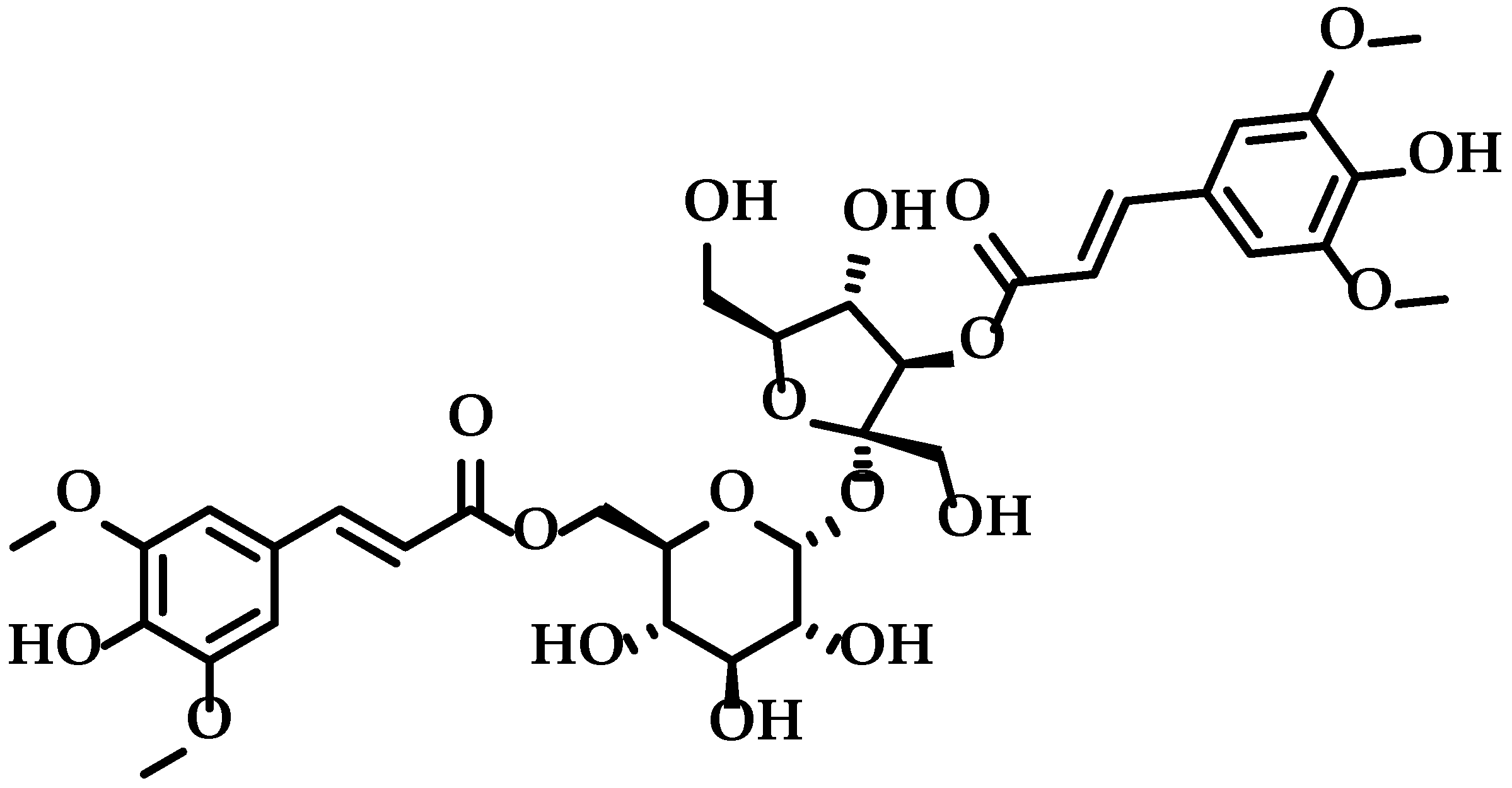

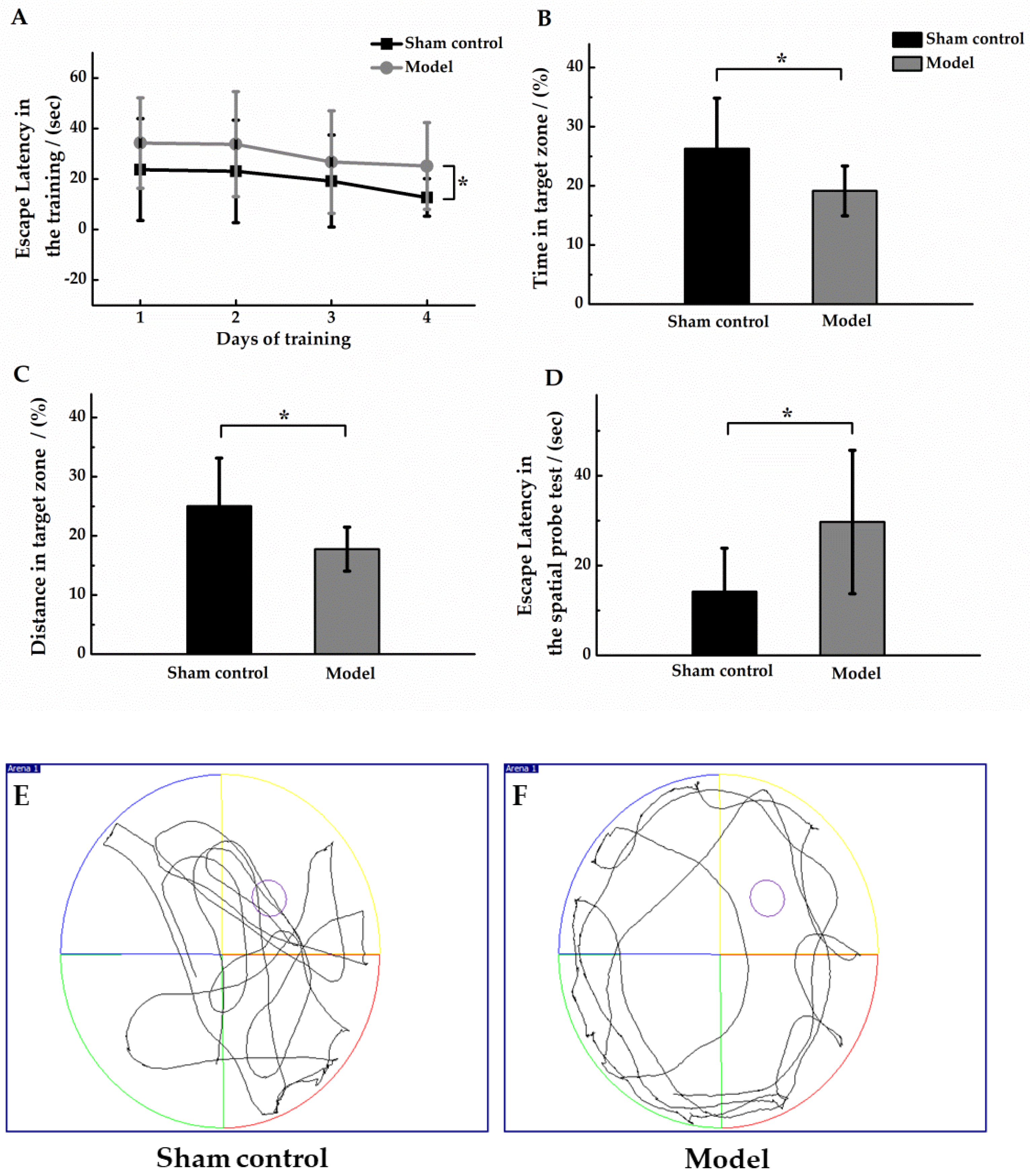
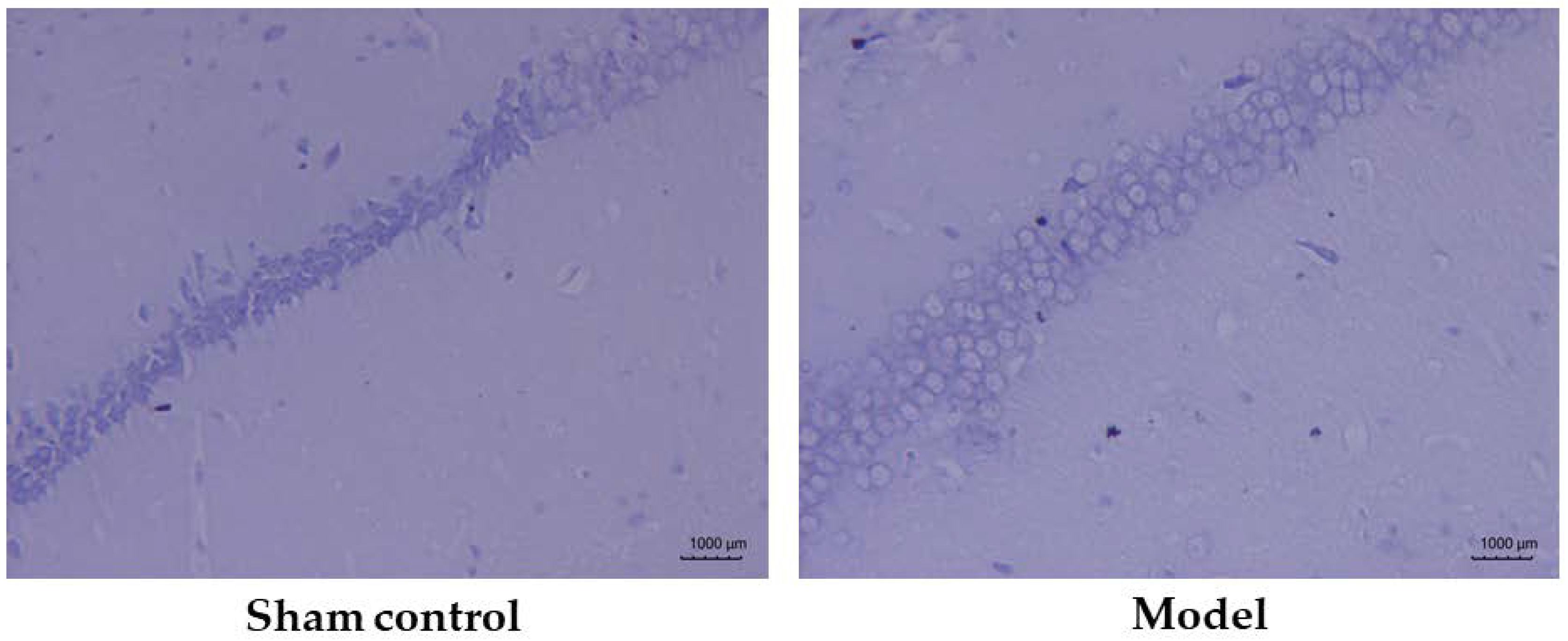
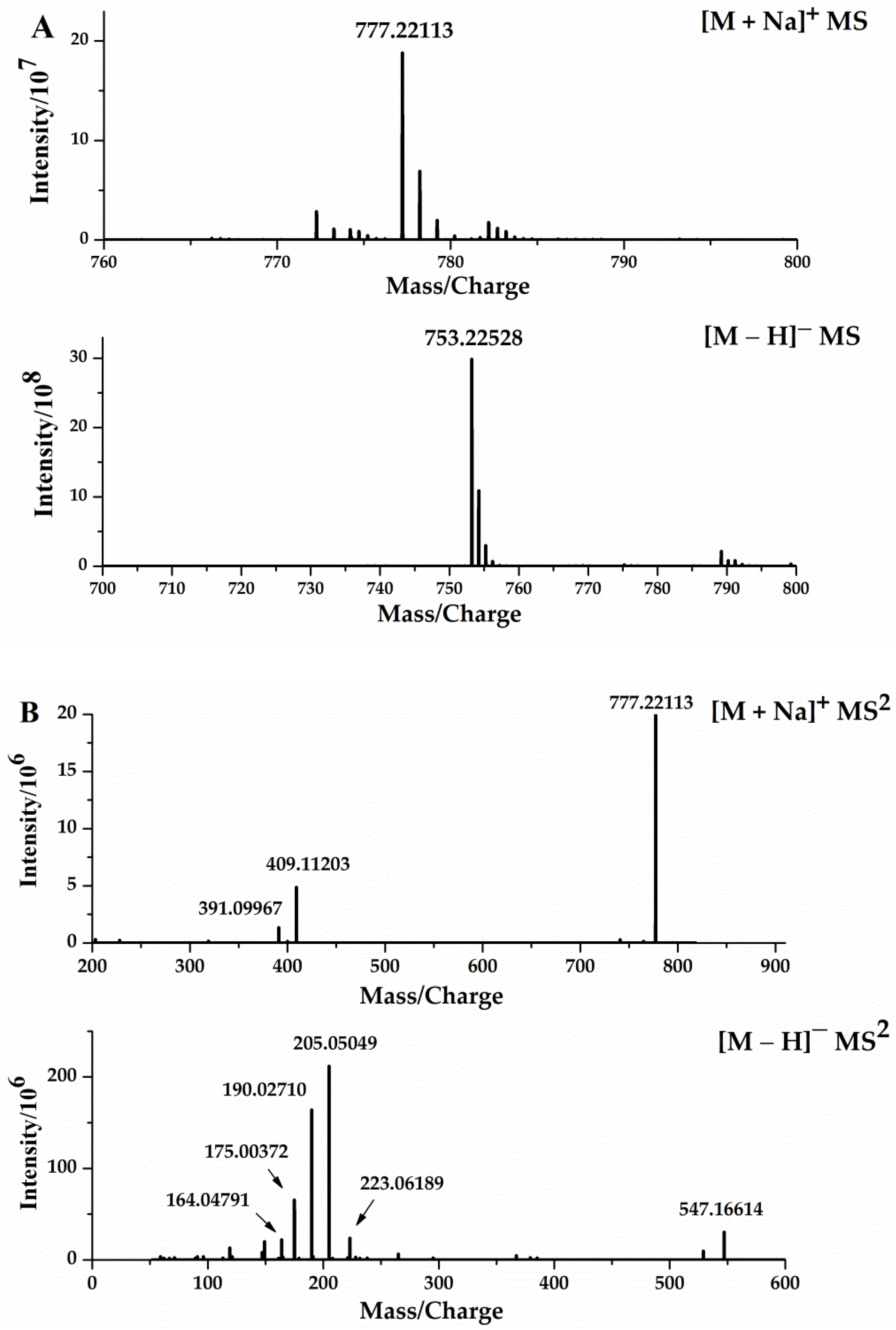
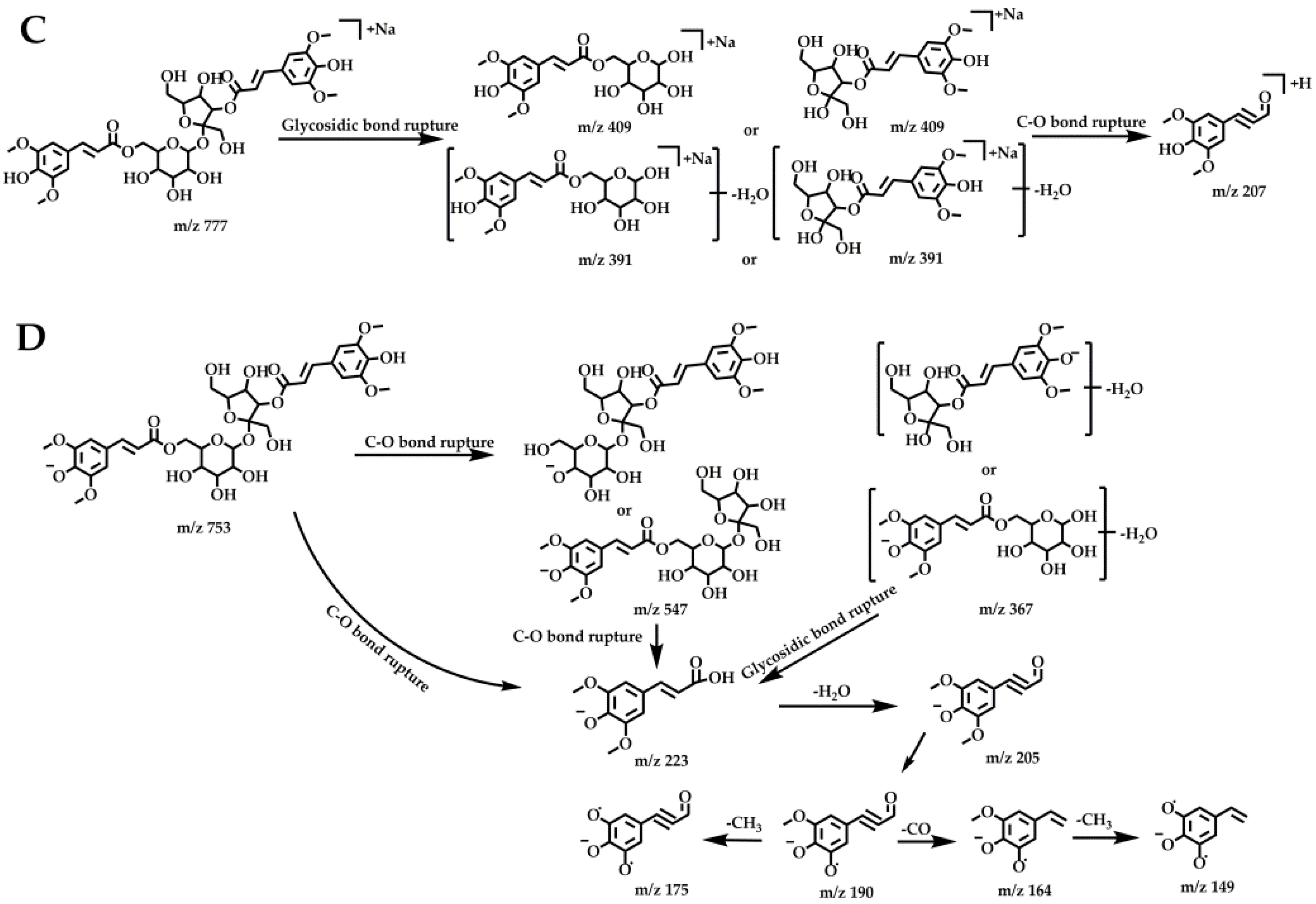
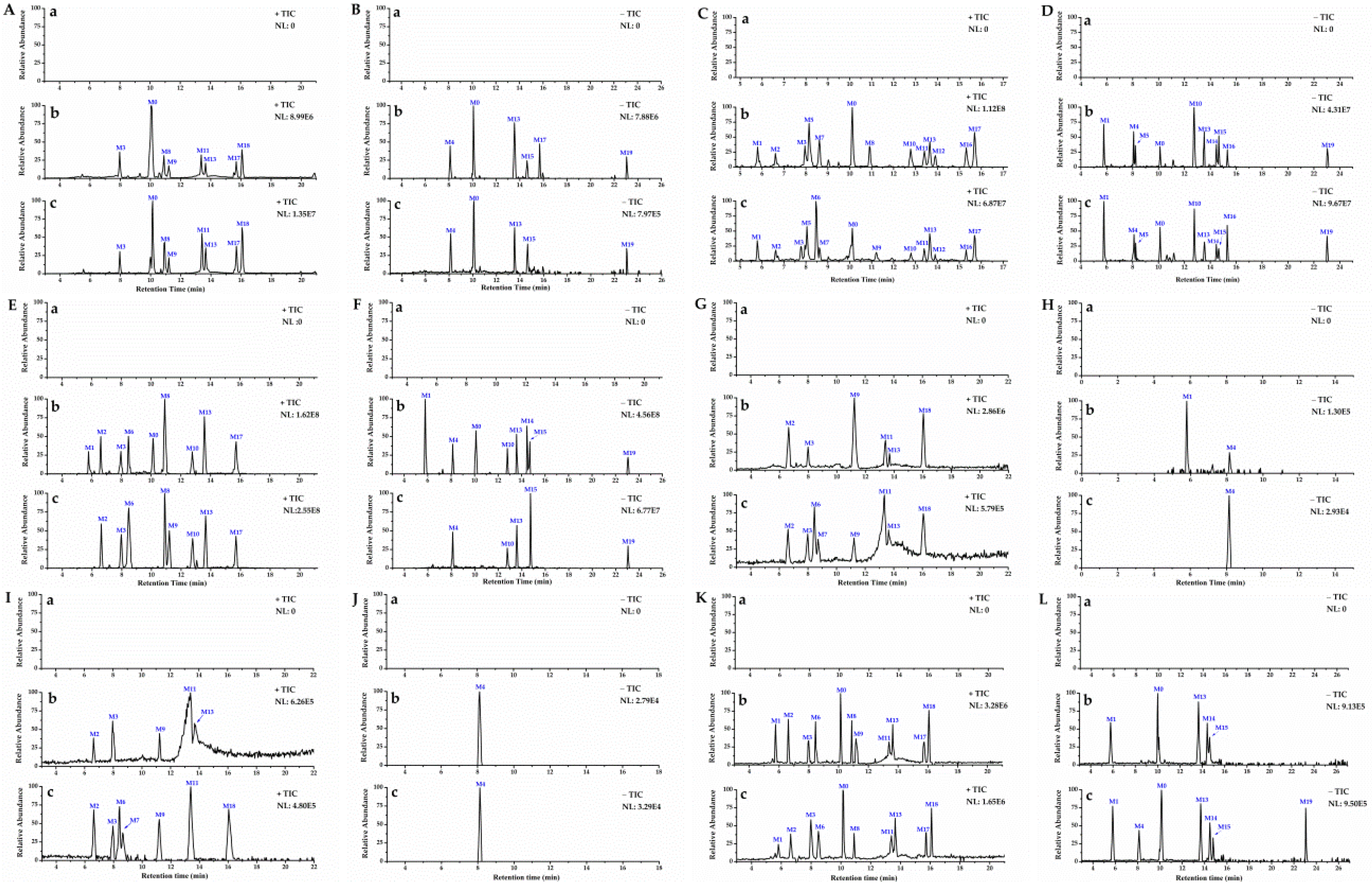
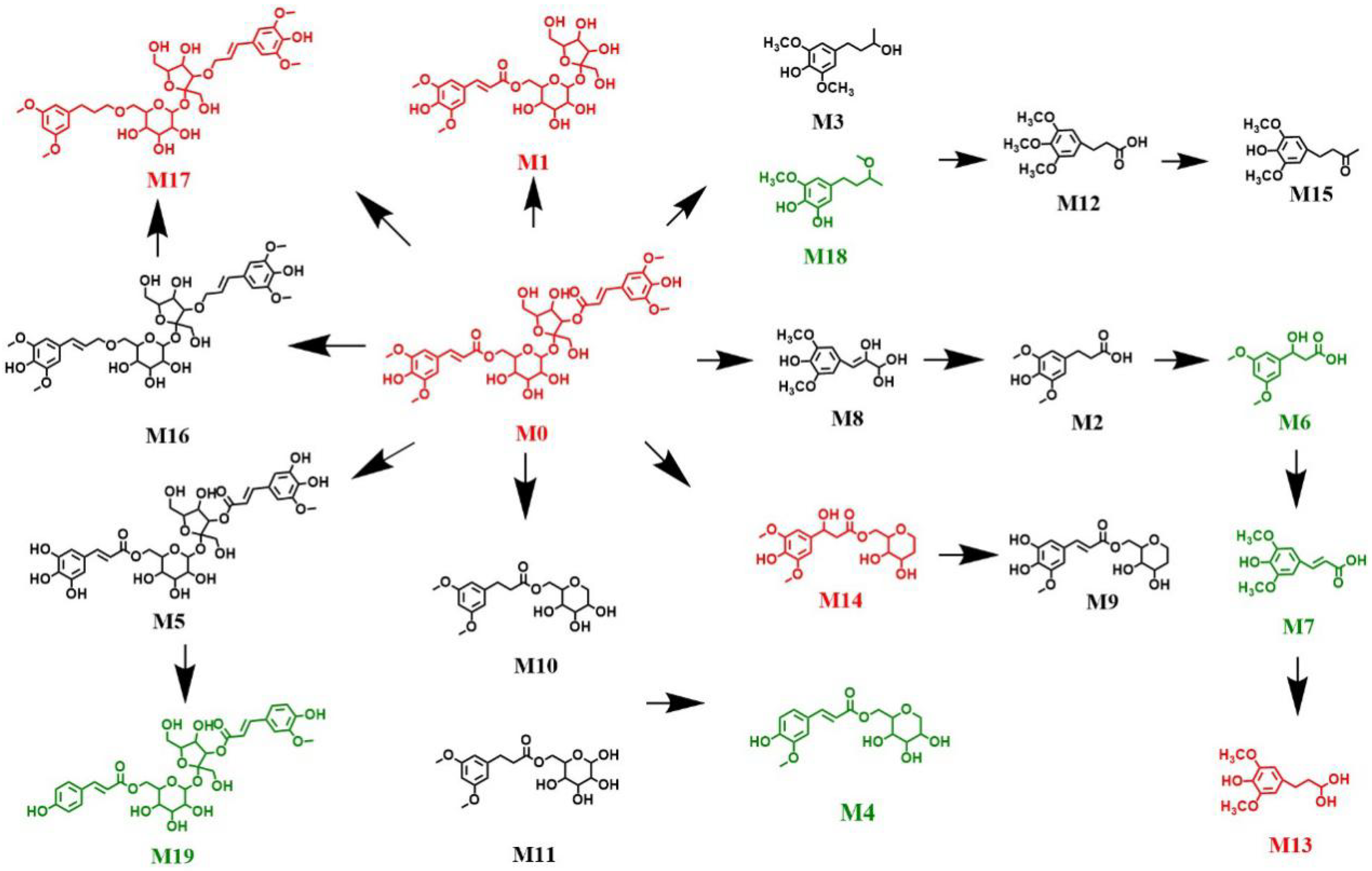
| Peak | TR/min | Formula | Exact Mass | Error (ppm) | Adduct Ion (m/z) | MS2 Fragment (m/z) | Identification/Reactions | Distribution | |
|---|---|---|---|---|---|---|---|---|---|
| Sham Control Group | Model Group | ||||||||
| M0 | 10.12 | C34H42O19 | 754.23148 | −0.309 | [M + Na]+ 777.22101 | 777.22113 (C34H42O19Na, 100), 409.11023 (C17H22O10Na, 21.58), 391.09967 (C17H20O9Na, 6.09) | DISS | 1, 2, 3, 6 | 1, 2, 6 |
| 10.11 | C34H42O19 | 754.23148 | 2.157 | [M − H]− 753.22528 | 205.05049 (C11H9O4, 100), 190.02710 (C10H6O4, 88.42), 175.00372 (C9H3O4, 28.26), 547.16614 (C23H31O15, 12.27), 164.04791 (C9H8O3, 8.76), 223.06189 (C11H11O5, 7.23) | 1, 2, 3, 6 | 1, 2, 6 | ||
| M1 | 5.78 | C23H32O15 | 562.15284 | −0.773 | [M + Na]+ 571.16290 | 571.16266 (C23H32O15Na, 100), 409.10941 (C17H22O10Na, 22.62), 391.10001 (C17H20O9Na, 6.90) | 6′-Sinapoyl sucrose | 2, 3, 6 | 2, 6 |
| 5.78 | C23H32O15 | 562.15284 | 1.724 | [M − H]− 547.16669 | 205.05058 (C11H9O4, 100), 190.02713 (C10H6O4, 57.13), 175.00354 (C9H3O4, 20.99), 547.16681 (C23H31O15, 18.35), 223.06117 (C11H11O5, 11.96) | 2, 3, 4, 6 | 2, 6 | ||
| M2 | 6.61 | C11H14O5 | 226.08357 | −0.529 | [M + H]+ 227.09128 | 181.04924 (C9H9O4, 100), 227.09102 (C11H15O5, 26.19), 209.08060 (C11H13O4, 21.94), 167.07001 (C9H11O3, 6.11) | C–O bond rupture reduction products of DISS | 2, 3, 4, 5, 6 | 2, 3, 4, 5, 6 |
| M3 | 7.96 | C12H18O4 | 226.11996 | −0.553 | [M + H]+ 227.12766 | 85.06531 (C5H9O, 100), 149.09598 (C10H13O, 63.70), 191.10643 (C12H15O2, 61.59), 209.11690 (C12H17O3, 60.39), 227.12654 (37.93) | Methylation product of M2 | 1, 2, 3, 4, 5, 6 | 1, 2, 3, 4, 5, 6 |
| M4 | 8.13 | C16H20O8 | 340.11527 | 3.792 | [M − H]− 339.10873 | 339.05457 (C11H15O12, 100), 259.09747 (C15H15O4, 57.77), 229.08693 (C14H13O3, 55.89), 122.03733 (C7H6O2, 9.81), 134.03729 (C8H6O2, 7.20), 295.09653 (C18H15O4, 5.07) | DISS demethoxylation product | 1, 2, 3, 4, 5 | 1, 2, 3, 4, 5, 6 |
| M5 | 8.14 | C31H36O19 | 712.18453 | 0.1914 | [M + Na]+ 735.17440 | 70.06594 (100), 245.11336 (C13H18O3Na, 41.27), 227.10280 (C13H16O2Na, 36.82), 277.11856 (C15H15O2, 32.87), 249.12337 (C16H18ONa, 27.44), 325.17694 (C19H26O3Na, 26.45), 343.18710 (C19H28O4Na, 24.09), 201.12357 (C12H18ONa, 21.03) | Demethylations product of DISS | 2 | 2 |
| 8.13 | C31H36O19 | 712.18453 | 2.299 | [M − H]− 711.17834 | 321.04388 (C11H13O11, 100), 241.08717 (C15H13O3, 25.58), 322.04718 (C18H10O6, 13.30), 294.13840 (C23H18, 10.90) | 2 | 2 | ||
| M6 | 8.46 | C11H14O5 | 226.08357 | −0.485 | [M + H]+ 227.09129 | 167.07014 (C9H11O3, 100), 177.05444 (C10H9O3, 5.15), 209.08076 (C11H13O4, 3.85) | C–O bond rupture reduction products of DISS | 3, 6 | 2, 3, 4, 5, 6 |
| M7 | 8.61 | C11H12O5 | 224.06792 | −0.222 | [M + H]+ 225.07570 | 207.06502 (C11H11O4, 100), 175.03889 (C10H7O3, 63.01), 192.04141 (C10H8O4, 21.64), 149.02347 (C8H5O3, 7.54), 164.04666 (C9H8O3, 5.36) | Sinapinic acid | 2 | 2,4,5 |
| M8 | 10.90 | C11H14O6 | 242.07849 | 1.921 | [M + H]+ 243.08733 | 243.08736 (C11H15O6, 100), 172.08670 (40.40), 216.07651 (29.79), 198.06587 (15.69), 197.08096 (C10H13O4, 0.46) | Hydroxylation of Sinapic acid | 1, 2, 3, 6 | 1, 2, 3, 6 |
| M9 | 11.21 | C16H20O8 | 340.11527 | −4.438 | [M + H]+ 341.12158 | 341.22040 (100), 238.19051 (C13H27O2Na, 4.07), 205.08562 (C11H9O4, 2.72), 323.09164 (C19H15O5, 2.71), 191.07014 (C11H11O3, 2.70), 107.08558 (C8H11, 2.32), 163.07523 (C10H11O2, 2.16) | DISS demethoxylation product | 1, 4, 5, 6 | 1, 2, 3, 4, 5 |
| M10 | 12.77 | C17H24O9 | 372.14148 | −1.856 | [M + Na]+ 395.13052 | 395.28958 (C25H40O2Na, 100), 377.27933 (C25H38ONa, 36.24), 107.08579 (C6H12Na, 9.68), 271.12012 (C11H20O6Na, 5.33), 359.26834 (C25H36Na, 5.17) | DISS glycosidic bond rupture product | 2, 3 | 2, 3 |
| 12.75 | C17H24O9 | 372.14148 | 3.399 | [M − H]− 371.13492 | 147.11789 (100), 371.17041 (C18H27O8, 67.35), 209.11717 (C12H17O3, 4.69), 179.05547 (2.83), 191.10738 (2.68), 149.04442 (C5H9O5, 2.16), 293.94162 (1.78), 207.10025 (1.73) | 2, 3 | 2, 3 | ||
| M11 | 13.39 | C17H24O9 | 372.14148 | −0.388 | [M + Na]+ 395.13120 | 395.20325 (C19H32O7Na, 100), 203.05223 (C6H12O6Na, 23.02), 201.03685 (C6H10O6Na, 6.26), 217.15601 (C13H22ONa, 5.52), 215.14053 (C13H20ONa, 4.39), 121.10120 (C9H13, 1.80) | DISS C=O bond fracture product | 1, 2, 4, 5, 6 | 1, 2, 4, 5, 6 |
| M12 | 13.90 | C12H16O5 | 240.09922 | 0.456 | [M + H]+ 241.10716 | 241.16249 (100), 123.116687 (C9H15, 25.31), 147.11676 (C11H15, 13.58) | Methylated product after reduction of sinapinic acid | 2 | 2 |
| M13 | 13.56 | C11H16O5 | 228.09923 | −0.338 | [M + Na]+ 251.08891 | 98.98458 (100), 251.08862 (C11H16O5Na, 76.53), 251.12540 (C12H20O4Na, 61.89), 141.09071 (C6H14O2Na, 7.51), 167.08630 (C11H12Na, 6.81), 173.13144 (C11H18Na, 5.06) | Sinapinic acid addition product | 1, 2, 3, 4, 5, 6 | 1, 2, 3, 4, 6 |
| 13.52 | C11H16O5 | 228.09923 | 4.976 | [M − H]− 227.09253 | 227.12891 (C12H19O4, 100), 183.13898 (C11H19O2, 30.81), 165.12851 (C11H17O, 27.80), 209.11829 (C12H17O3, 25.19) | 1, 2, 3, 6 | 1, 2, 3, 6 | ||
| M14 | 14.48 | C17H24O9 | 372.14148 | −3.418 | [M − H]− 371.13239 | 371.11700 (C13H23O12, 100), 291.16016 (C17H23O4, 66.46), 79.95737 (30.93), 247.17033 (C16H23O2, 30.14), 371.24493 (24.66), 122.03730 (17.26), 123.04517 (13.98), 135.04510 (13.06) | DISS glycosidic bond rupture product | 2, 3, 6 | 2, 6 |
| M15 | 14.64 | C12H16O4 | 224.10431 | 3.382 | [M − H]− 223.09724 | 223.11705 (C9H19O6, 100), 122.10566 (C9H14, 13.98), 179.12711 (C8H19O, 44.85) | Reductive product of M12 | 1, 2, 3, 6 | 1, 2, 3, 6 |
| M16 | 15.32 | C34H46O17 | 726.27295 | −1.947 | [M + H]+ 727.28077 | 409.09137 (C22H17O8, 100), 427.10205 (C22H19O9, 98.04), 391.08096 (C22H15O7, 72.55), 379.08099 (C21H15O7, 71.11), 511.12332 (C26H23O11, 50.98), 481.11246 (C25H21O10, 50.12), 325.07050 (C18H13O6, 40.00), 349.07037 (C20H13O6, 33.57), 337.07034 (C19H13O6, 24.35), 355.08121 (C19H15O7, 23.50) | DISS reduction product | 2 | 2 |
| 15.30 | C34H46O17 | 726.27295 | 1.2745 | [M − H]− 725.26600 | 353.06680 (100) 443.09808 (C22H19O10, 76.65), 473.10849 (C23H21O11, 34.99), 725.19037 (C32H37O19, 33.48), 545.12988 (C26H25O13, 18.62), 413.08752 (C21H17O9, 15.06), 407.07764 (C22H15O8, 11.06) | 2 | 2 | ||
| M17 | 15.69 | C34H48O17 | 728.28860 | −4.986 | [M + H]+ 729.29643 | 127.03926 (C6H7O3, 100), 189.08713 (C12H13O2, 53.89), 156.07675 (C8H12O3, 41.81), 155.08171 (C12H11, 19.55), 213.09970 (C7H17O7, 16.21), 159.07664 (C11H11O, 15.36) | Reduction products of dehydroxy DISS | 1, 2, 3, 6 | 1, 2, 3, 6 |
| 15.70 | C34H48O17 | 728.28860 | −0.135 | [M − H]− 727.28078 | 212.00232 (100), 217.01762 (C4H9O10, 43.23), 80.96514 (21.35), 261.00748 (C12H5O7, 17.73), 213.00554 (C8H5O7, 10.55), 137.06081 (C8H9O2, 10.27) | 1 | − | ||
| M18 | 16.04 | C12H18O4 | 226.11996 | 0.5040 | [M + H]+ 227.1279 | 227.06352 (C12H12O3Na, 100), 209.11656 (C12H17O3, 71.14) | Position isomer of M3 | 1, 4, 6 | 1, 4, 5, 6 |
| M19 | 23.05 | C31H36O16 | 664.18453 | −1.938 | [M − H]− 663.17542 | 112.98559 (100), 323.22034 (C19H31O4, 32.70), 255.23296 (C16H31O2, 25.16), 391.20743 (C29H27O, 10.03) | Demethylations product of DISS | 1, 2, 3 | 1, 2, 3, 6 |
Publisher’s Note: MDPI stays neutral with regard to jurisdictional claims in published maps and institutional affiliations. |
© 2021 by the authors. Licensee MDPI, Basel, Switzerland. This article is an open access article distributed under the terms and conditions of the Creative Commons Attribution (CC BY) license (https://creativecommons.org/licenses/by/4.0/).
Share and Cite
Yuan, J.; Wang, H.; Wang, Y.; Wang, Z.; Huo, Q.; Dai, X.; Zhang, J.; Sun, Y. Rapid Identification of 3,6′-Disinapoyl Sucrose Metabolites in Alzheimer’s Disease Model Mice Using UHPLC–Orbitrap Mass Spectrometry. Molecules 2022, 27, 114. https://doi.org/10.3390/molecules27010114
Yuan J, Wang H, Wang Y, Wang Z, Huo Q, Dai X, Zhang J, Sun Y. Rapid Identification of 3,6′-Disinapoyl Sucrose Metabolites in Alzheimer’s Disease Model Mice Using UHPLC–Orbitrap Mass Spectrometry. Molecules. 2022; 27(1):114. https://doi.org/10.3390/molecules27010114
Chicago/Turabian StyleYuan, Jiaqi, Han Wang, Yunting Wang, Zijian Wang, Qing Huo, Xueling Dai, Jiayu Zhang, and Yaxuan Sun. 2022. "Rapid Identification of 3,6′-Disinapoyl Sucrose Metabolites in Alzheimer’s Disease Model Mice Using UHPLC–Orbitrap Mass Spectrometry" Molecules 27, no. 1: 114. https://doi.org/10.3390/molecules27010114
APA StyleYuan, J., Wang, H., Wang, Y., Wang, Z., Huo, Q., Dai, X., Zhang, J., & Sun, Y. (2022). Rapid Identification of 3,6′-Disinapoyl Sucrose Metabolites in Alzheimer’s Disease Model Mice Using UHPLC–Orbitrap Mass Spectrometry. Molecules, 27(1), 114. https://doi.org/10.3390/molecules27010114





